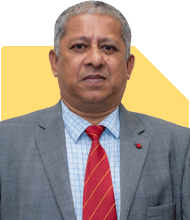Ramalingam Kalirajan |10017 Answers |Ask -Follow
Mutual Funds, Financial Planning Expert - Answered on Jul 05, 2024
He has an MBA in finance from the University of Madras and is a certified financial planner.
He is the director and chief financial planner at Holistic Investment, a Chennai-based firm that offers financial planning and wealth management advice.... more

I am 50 year old. I have a home of 90 lakhs, loan outstanding is 20 lakhs. I am earning 1.5 lakhs per month. My children have completed their education and are working. I have ancestral property of around 50 lakhs. I want to retire at 60 years and loners 1 lakh rupees per month post retirement. How can I do this?
Understanding Your Current Financial Situation
Firstly, let's appreciate your current financial standing. At 50 years old, you own a home worth Rs. 90 lakhs, with an outstanding loan of Rs. 20 lakhs. You have an ancestral property valued at around Rs. 50 lakhs, and you are earning Rs. 1.5 lakhs per month. Your children have completed their education and are now working, which is excellent as it reduces your financial obligations. Your goal is to retire at 60 and have a monthly income of Rs. 1 lakh post-retirement. Let's explore how to achieve this.
The Power of Mutual Funds
Mutual funds are a versatile and powerful tool for wealth creation. They offer various categories that cater to different risk appetites and investment horizons. The advantages of mutual funds include professional management, diversification, liquidity, and the potential for significant returns through compounding.
Systematic Withdrawal Plan (SWP)
An SWP is a facility offered by mutual funds that allows you to withdraw a fixed amount at regular intervals, typically monthly. This is perfect for generating a steady income post-retirement. The beauty of an SWP is that it provides regular income while allowing the remaining corpus to continue growing.
Advantages of SWP:
Steady Income: Ensures a regular income stream.
Tax Efficiency: Withdrawals are treated as capital gains, which can be more tax-efficient compared to regular income.
Flexibility: You can adjust the withdrawal amount as per your needs.
Compounding: The remaining corpus continues to grow, benefiting from compounding.
Building Your Retirement Corpus
Given that you have 10 years until retirement, we need to build a sufficient corpus that can support a monthly withdrawal of Rs. 1 lakh. Let's discuss a strategic approach to achieve this.
Step-by-Step Strategy
1. Clearing Outstanding Loans
Firstly, it’s essential to clear the outstanding home loan of Rs. 20 lakhs. This will reduce your financial burden and provide peace of mind.
2. Investing in Mutual Funds
With a focus on growth, you can allocate a portion of your income and other savings into mutual funds. Here’s a suggested approach:
Equity Mutual Funds:
Large-Cap Funds: These funds invest in well-established companies with a large market capitalization. They offer moderate returns with relatively lower risk.
Mid-Cap Funds: These invest in mid-sized companies with high growth potential. They carry more risk but offer higher returns.
Small-Cap Funds: Investing in small companies, these funds are high-risk but can offer substantial returns.
Debt Mutual Funds:
Corporate Bond Funds: These invest in high-rated corporate bonds and offer stable returns with low risk.
Government Securities (G-Secs): These are sovereign securities with very low risk and stable returns.
Hybrid Funds:
Balanced Advantage Funds: These funds invest in both equities and debt instruments, balancing risk and return.
Investment Allocation
Based on your risk profile and investment horizon, a diversified portfolio might include:
40% in Large-Cap Funds for stability
30% in Mid-Cap Funds for growth
20% in Debt Funds for safety
10% in Balanced Advantage Funds for risk management
Regular Monitoring and Rebalancing
Regularly review your portfolio to ensure it aligns with your goals. Rebalancing helps maintain the desired asset allocation and manage risks effectively.
Implementing SWP for Retirement Income
Once you retire, you can start an SWP from your accumulated mutual fund corpus. Here’s how to set it up:
Determine the Withdrawal Amount: Based on your need for Rs. 1 lakh per month, set up the SWP accordingly.
Choose the Right Funds: Select funds that match your risk tolerance and withdrawal needs.
Monitor and Adjust: Regularly review the SWP to ensure it meets your income requirements without depleting the corpus too quickly.
Tax Considerations
SWP withdrawals are subject to capital gains tax. For equity funds, long-term capital gains (holding period > 1 year) are taxed at 10% if gains exceed Rs. 1 lakh in a financial year. For debt funds, long-term gains (holding period > 3 years) are taxed at 20% with indexation benefits. This can be more tax-efficient compared to regular income.
Building an Emergency Fund
It's crucial to maintain an emergency fund to cover unexpected expenses. Typically, this should cover 6-12 months of living expenses. This can be kept in a high-liquidity, low-risk instrument like a liquid fund.
Diversifying Your Investments
While mutual funds are a significant part of your strategy, diversification is key. Consider spreading investments across different asset classes:
Gold: It acts as a hedge against inflation and market volatility. You can invest in gold ETFs or sovereign gold bonds.
PPF and EPF: These are safe and offer guaranteed returns. They should be part of your retirement planning.
Assessing Risk and Return
Always evaluate the risk and potential returns of your investments. Mutual funds, while offering good returns, come with market risk. Debt funds, though safer, provide lower returns. Balance your portfolio to match your risk appetite.
Power of Compounding
One of the greatest advantages of mutual funds is the power of compounding. By reinvesting your earnings, your wealth grows exponentially over time. Start early and be consistent with your investments to maximize the benefits of compounding.
Best Practices for Retirement Planning
Start Early: The earlier you start, the more you benefit from compounding.
Be Consistent: Regular investments, even in small amounts, build substantial wealth over time.
Diversify: Spread investments across different asset classes to manage risk.
Monitor and Rebalance: Regularly review and adjust your portfolio to stay on track.
Choosing Regular Funds Over Direct Funds
When it comes to investing in mutual funds, you have the option to choose between direct funds and regular funds. Direct funds have a lower expense ratio as they do not involve the cost of a distributor. However, investing through a Mutual Fund Distributor (MFD) with a Certified Financial Planner (CFP) can be more beneficial for several reasons.
Disadvantages of Direct Funds
Lack of Guidance: Direct funds require you to do all the research and monitoring yourself. This can be challenging if you lack financial expertise.
Higher Risk: Without professional guidance, you may make suboptimal investment choices, increasing your risk.
Time-Consuming: Managing and monitoring your investments can be time-consuming.
Advantages of Regular Funds
Professional Guidance: An MFD with CFP credentials provides expert advice tailored to your financial goals.
Regular Monitoring: They monitor your investments and make necessary adjustments to keep your portfolio on track.
Holistic Financial Planning: They offer comprehensive financial planning, including tax planning, retirement planning, and risk management.
Peace of Mind: Having a professional manage your investments gives you peace of mind, knowing your finances are in capable hands.
How a Certified Financial Planner Can Help You
A CFP is a highly qualified professional who can provide you with personalized financial advice and planning. Here's how a CFP can assist you in achieving your retirement goals:
Comprehensive Financial Planning
A CFP takes a holistic view of your financial situation, considering all aspects such as income, expenses, assets, liabilities, and future goals. They create a comprehensive plan that aligns with your retirement objectives.
Customized Investment Strategy
Based on your risk tolerance, investment horizon, and retirement goals, a CFP designs a customized investment strategy. They recommend the right mix of equity, debt, and hybrid funds to optimize your returns while managing risk.
Regular Monitoring and Rebalancing
A CFP regularly monitors your portfolio's performance and rebalances it to maintain the desired asset allocation. This ensures your investments stay aligned with your goals and adapt to changing market conditions.
Tax Planning
Tax efficiency is crucial for maximizing your retirement corpus. A CFP provides expert tax planning advice to minimize your tax liability on investments and withdrawals.
Risk Management
A CFP assesses your risk exposure and recommends appropriate insurance coverage to protect you and your family from financial uncertainties.
Estate Planning
To ensure your wealth is transferred smoothly to your heirs, a CFP helps with estate planning, including wills, trusts, and nominations.
Final Insights
Planning for retirement is a journey that requires careful planning, disciplined investing, and regular monitoring. By leveraging the power of mutual funds and SWP, you can create a sustainable income stream that supports your lifestyle post-retirement.
Your proactive approach to planning, coupled with the right strategies, will ensure you enjoy a comfortable and financially secure retirement. Remember, the key is to start early, be consistent, and stay informed.
If you need personalized guidance or have any questions, feel free to reach out. Best of luck on your journey to a fulfilling retirement!
Best Regards,
K. Ramalingam, MBA, CFP
Chief Financial Planner
www.holisticinvestment.in
You may like to see similar questions and answers below
Ramalingam Kalirajan |10017 Answers |Ask -Follow
Mutual Funds, Financial Planning Expert - Answered on Jul 11, 2024
Ramalingam Kalirajan |10017 Answers |Ask -Follow
Mutual Funds, Financial Planning Expert - Answered on Jul 16, 2024
Ramalingam Kalirajan |10017 Answers |Ask -Follow
Mutual Funds, Financial Planning Expert - Answered on Jul 15, 2024
Ramalingam Kalirajan |10017 Answers |Ask -Follow
Mutual Funds, Financial Planning Expert - Answered on Oct 27, 2024
Prof Suvasish Mukhopadhyay |2742 Answers |Ask -Follow
Career Counsellor - Answered on Jul 31, 2025
Prof Suvasish Mukhopadhyay |2742 Answers |Ask -Follow
Career Counsellor - Answered on Jul 31, 2025
Dr Nagarajan J S K |2116 Answers |Ask -Follow
NEET, Medical, Pharmacy Careers - Answered on Jul 31, 2025
Dr Nagarajan J S K |2116 Answers |Ask -Follow
NEET, Medical, Pharmacy Careers - Answered on Jul 31, 2025
Dr Nagarajan J S K |2116 Answers |Ask -Follow
NEET, Medical, Pharmacy Careers - Answered on Jul 31, 2025
Dr Nagarajan J S K |2116 Answers |Ask -Follow
NEET, Medical, Pharmacy Careers - Answered on Jul 31, 2025
Dr Nagarajan J S K |2116 Answers |Ask -Follow
NEET, Medical, Pharmacy Careers - Answered on Jul 31, 2025
Nayagam P P |9752 Answers |Ask -Follow
Career Counsellor - Answered on Jul 31, 2025
Nayagam P P |9752 Answers |Ask -Follow
Career Counsellor - Answered on Jul 31, 2025
Ravi Mittal |629 Answers |Ask -Follow
Dating, Relationships Expert - Answered on Jul 31, 2025




















